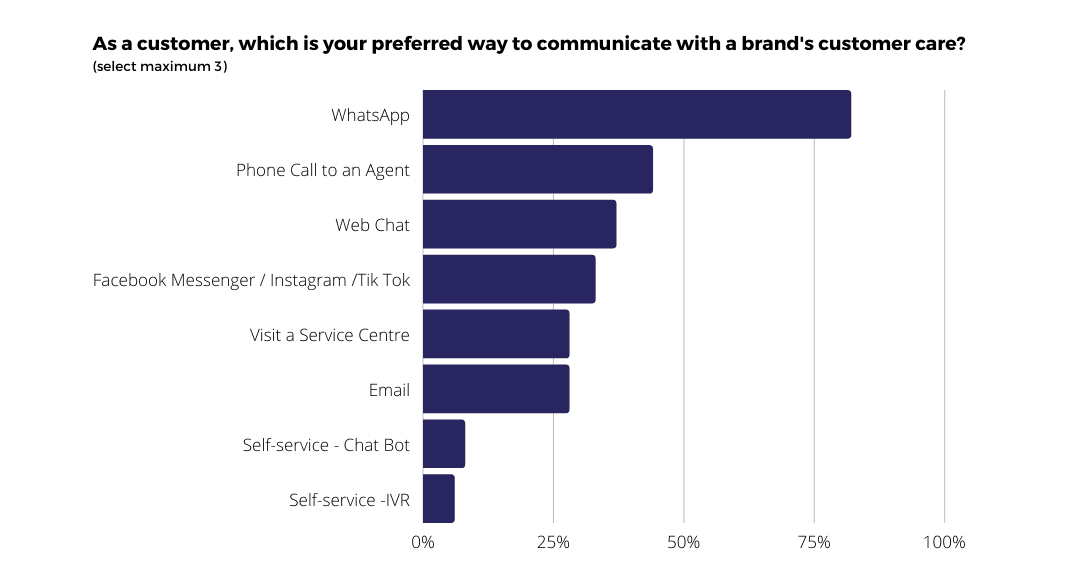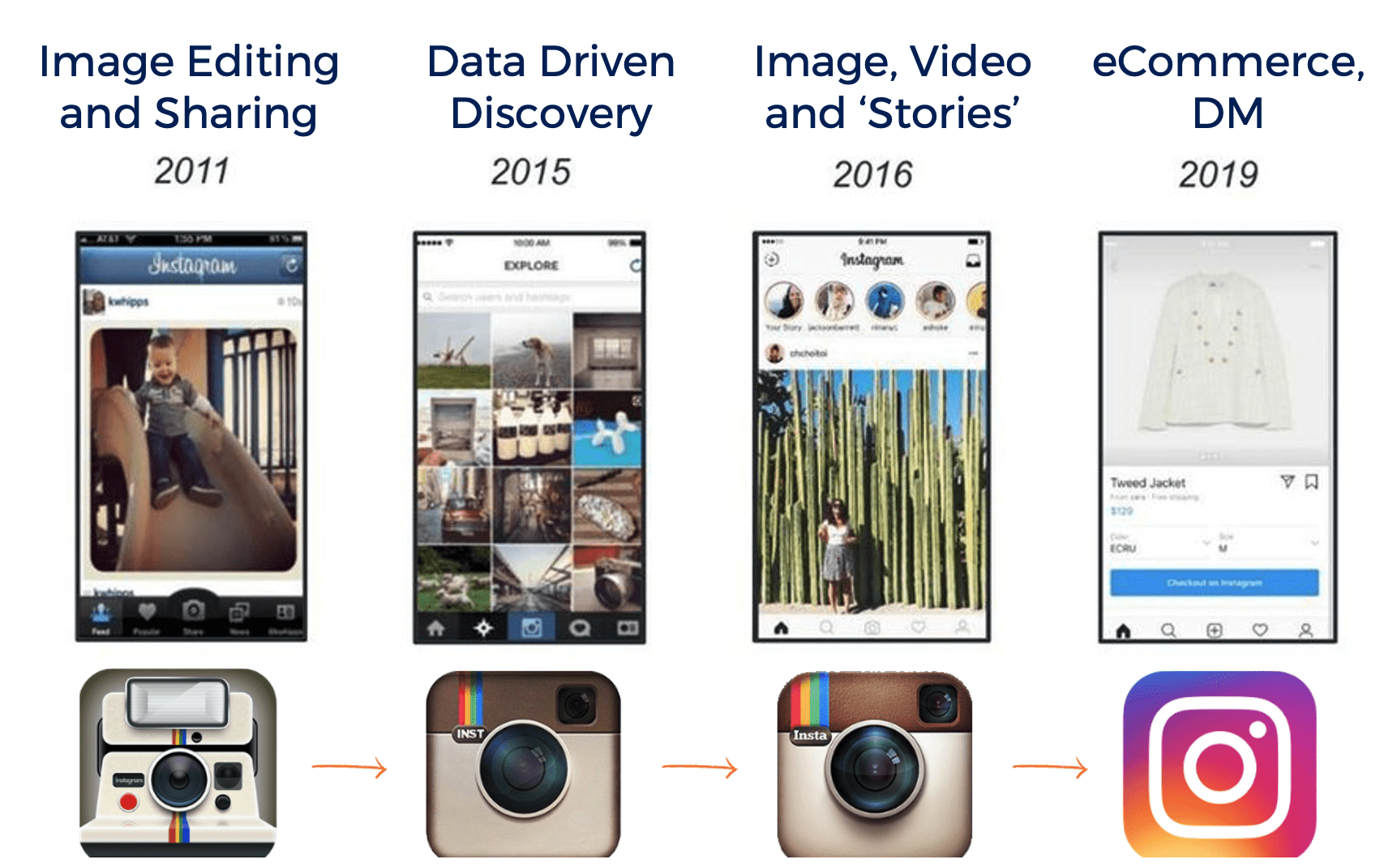It’s a well understood fact by customer driven businesses that customers are demanding more flexibility than ever before. They want businesses to meet them where they are, rather than feeling forced to do the work of tracking us down and navigating our service systems to get what they need.
But there’s a disconnect. Calling an agent remains the benchmark for delivering a solution, but it’s almost never what customers want anymore.
During my recent presentation to over 160 customer service industry professionals, I took a quick poll to better understand what channels they preferred to interact with brands.

The results of this poll, really showed a couple of important points to consider:
- In order to please most of our customers, we need to be able to interact with them in more than one way, because different customer segments have different preferences. This does not only apply based on demographic differences, but also geographically there are clear variations. For example, this poll was conducted in Indonesia where Whatsapp is the most preferred tool. However, I’d doubt whether a similar poll would result in the same top choice in, for example, Australia, where Whatsapp is not nearly as popular for business interactions;
- The significant lead shown for Whatsapp would have not occurred if this poll were taken 5 to 10 years ago. The emergence of new technology and the speed at which people take them up, really makes it essential for companies to ensure they have the flexibility and ability to make quick adjustments, to keep up with their customers.
So, based on the variety of answers in this poll – How do we reset the vision for the future of delivering great customer satisfaction today and into the future?
Basic technology updates have seen better diallers and CRMs enter the business, and many chat bots installed on websites. Incremental improvements that give us a better place to start a new query but fail to maximise customer satisfaction if they live in siloed systems.
Often businesses are implementing solutions that better service their own agenda for efficiencies but at the detriment of the customer experience and the outcomes customers are trying to achieve.
The future of the customer service and contact centre industry must become more adaptive. In a world where social media services shift in popularity faster than we typically upgrade our contact platforms, we need to be investing in technologies that give us the core capabilities we need to let customers reach us from where they already are.
Even applications themselves experience a rapid revolution of how they bring value to customers. Instagram began as a photo publishing platform with filters and sharing capabilities, and has now evolved to an ecommerce and messaging platform.

Indonesia was once dominated by BBM (Blackberry Messenger) as the standard messaging platform across the nation. But then, almost overnight, WhatsApp became the new standard. And now, I’ve noticed my son often uses Instagram as a messaging platform, while we’re hearing some consumers are even starting to look for ways to talk to companies via TikTok.

As businesses, we can’t predict which specific platforms are going to win in the future and we can waste a lot of money if we try. But we must embrace this uncertainty by accepting our need to improve readiness for whatever twists and turns lie ahead. Customers will expect us to be ready as soon as they want to reach us.
By meeting customers where they are, anywhere, anytime, on the device they’re on, we can achieve great results that strengthens the loyalty and trust customers place in our businesses.
Tech to serve the customer journey
We must always remember that the technology itself is not the solution. Great technology serves customers best when they don’t even think about how to reach us and solve the problem that they’ve realised they need our help with.
Elevating our thinking, technology is always about serving the customer journey. They contact us when they have a need. How do we meet that need as effectively as possible?
The right technology enables the simplest path for the customer, minimising the friction points between their first contact and the right solution. With that in mind, it becomes clear that along with flexibility and adaptability comes interoperability. We want our systems to interact with whatever systems our customers are trying to reach us through.
A customer should be able to start a chat from their favourite chat service and if they need to be transferred to a voice call the agent should have visibility of the chat information to pick up right from where the customer left off. That’s the kind of experience that delights a customer – because they’re used to the frustration of needing to start over again.
Gartner highlights there are some key actions organisations can take to improve customer satisfaction:
(Source: Gartner, Inc. | G00728891 Digital Trust Drives Customer Satisfaction March 2022)
- Establish Digital Trust – instill confidence through secure applications. Technology is a tool that can be used to help gain customers’ trust, if they find the technology easy to engage with and if it is secure and doesn’t compromise privacy or security
- Effortless experience – Making it easy for customer to achieve their desired action. While the security and privacy aspects of technology are widely recognized, functionality and performance of customer facing technologies are often overlooked and underutilized.
- Continuous improvement through KPIs understanding your Customer Satisfaction. Organizations should not be afraid to create and test metrics that serve as broader key or leading performance indicators (KPIs), since there is no single list of metrics that works for every organization, even within the same industry. Companies also need to set the right KPIs and have the tools to be able to measure these regularly to monitor performance.
We find many organisations are constrained by the reports in their contact centre application, and are unable to have clear visibility of their customer interactions.
ipSCAPE Insights provides a scalable, high-performance database securely hosted on Azure and a pre-built connector to leading BI tools that turn your historical data into valuable reports and analytics.
These reports allow you to gain a deeper understanding of your customers’ journey by consolidating information from your contact centre and other data sources such as Sales, Finance and Marketing so you can create actionable outcomes for your business.
Keeping your technology up-to-date and aligned with the ever-changing customer wants and needs, can be an expensive – and often risky – task.
You do not want to invest heavily in a new technological innovation when you have no way of knowing for how long it will still be relevant. That’s why it is important to align your technology strategy and partnerships with flexible products that will allow you to easily adjust and will not cost you significant set-up or legacy costs. This applies to changes in the technology but also to changes in capacity and ways of using it. Cloud technology has made this possible for most types of products and services.
At ipSCAPE, we also know we can’t predict the right platform for all occasions now and into the future. So, the company’s contact centre technology is built on Microsoft Azure. We trust Microsoft to be watching the horizon closely for what’s coming next and to keep its cloud platform ready and adaptable. And as an already highly flexible and interoperable platform, ipSCAPE can support open APIs and connect with systems like Salesforce, Zendesk, ServiceNow, or whatever CRM, ERP, reporting or analytics platform is required.
Here are some interesting ways we have seen innovative solutions co-created by ipSCAPE that could shape your idea of what can be achieved to improve your customer journeys:
- Wine delivery company, Wine Selectors, found that its most crucial moment for customer satisfaction and long-term retention was the very first delivery. So it designed an automation to trigger an SMS at the moment the first box was delivered and request NPS feedback. If the score was low, a call was sent to the dialler for a contact centre agent to proactively reach out and improve the situation as quickly as possible.
- An Australian energy company uses automated response on its IVR when there’s an outage on its networks to acknowledge the problem and that it is being resolved without overloading its contact centre to respond to customers who just want to know the problem has been identified.
- Online travel agent Traveloka operates 9 contact centres across 5 countries servicing 7 different markets across south-east Asia. They leverage ipSCAPE’s CTI adaptor to create seamless interoperability between their contact centres and their Salesforce CRM. The CTI Adaptor provides agents with access to call control features, embedding the ipSCAPE agent toolbar, directly within the CRM application. They are able to increase agent productivity using customer screen-pops, click to dial and call recording with call information automatically logged in Salesforce.
- Another element of the rapid changes in technology and customer requirements is that we cannot easily predict demand for certain products as well as when technical issues may arise that will require customer interactions. As such, companies need their customer services systems to be very flexible and rapidly scalable (up and down) to ensure continuous service while remaining cost efficient. Especially high growth challenger brands require this flexibility. Allied Credit is a privately-owned finance company and are the retail finance business partner of choice for an increasing array of well-known leading brands and dealer groups in the automotive, motorcycle, marine and recreation industries. ipSCAPE is able to scale with their growth, which has grown from 14 agents to over 100 in a year.
- The contact centre managing Australia’s national crisis support helpline is mission critical to operations of this mental health not-for-profit, so ensuring a robust fail-safe solution is crucial. However, replicating their existing on-premise contact centre technology was prohibitively expensive. In response ipSCAPE offered a cost-effective cloud solution which can be activated in minutes and has a greater flexibility to respond to different emergency scenarios. ipSCAPE’s system provides all the features and functionality that they enjoy with their existing on-premise system, which also ensures continuity in business operations. This not-for-profit organisation can now switch allocated volunteer crisis supporters over to the ipSCAPE solution in a matter of minutes. The cloud platform allows volunteers to take calls from any location in Australia with an Internet connection. It also means this not-for-profit can update its Interactive Voice Response (IVR) technology with new messages in minutes. So rather than not being able to get through to support workers, callers can now be informed and updated about the hotline’s technical problems and assured their call will be answered as quickly as possible. The technology also has the capability to flag calls with safety issues that can be traced by emergency services. The inherent flexibility of ipSCAPE’s solution means avoiding the expensive costs associated with traditional disaster recovery solutions and removing the need to invest considerable resources in maintaining a second physical back-up contact centre. In addition, the highly intuitive ipSCAPE interface means this not-for-profit does not need to dedicate significant resource to training volunteers on how to use a different system.
With platform flexibility and the use of APIs to operate a fully integrated contact centre, you create many new opportunities for proactive customer engagement and first-class satisfaction outcomes.
Challenges remain in how we manage our contact centre metrics to ensure we are truly measuring for customer satisfaction. With technologies like “maintain position in queue”, we can give a customer the luxury of hanging up during their query instead of waiting on hold and then call them back when they are next in line. A far more satisfying experience, but if we don’t update hold time KPIs we might think performance has not changed or potentially become even worse. Knowing we are measuring the right things is essential to maximise satisfaction in the midst of so much change.
Change will continue faster than ever before, and old contact centre technologies cannot keep up. There is no crystal ball, but we can build for what’s next in a way that makes us future-proof, ready to adapt to each new customer preference as they emerge.
At the heart of what we do – ipSCAPE is focused on the customer experience.
We believe the customer experience is so important to drive loyalty, engagement and growth for organisations, so we built the tools needed to create incredible customer moments that surprise and delight.
ipSCAPE is a cloud customer experience technology solution that is feature rich, scalable and has advanced integration capabilities.
We help businesses connect with their customers through multi-channel communications including Voice, Web Chat, Email, SMS, IVR, and other emerging channels.
We integrate with CRM and Business Intelligence applications to enhance strategic insights and customer engagement.

